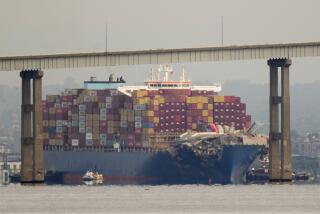9 Months After the Dona Paz Sank, Philippine Shipping Disaster Is Still a Mystery
- Share via
MANILA — Nine months after the Dona Paz sank in the world’s worst peacetime shipping disaster, the death toll remains a mystery and secrecy surrounds official investigations into the cause of the accident.
The 2,215-ton Dona Paz collided Dec. 20 with the 629-ton oil tanker Vector off Mindoro Island. Both vessels exploded in huge fireballs.
Only 26 of the 1,775 people known to have been on board the vessels were saved, but the real death toll may never be known.
Manifests on Philippine inter-island vessels are notoriously inaccurate. They often record children as “half-passengers” or disregard them entirely. Corrupt officials frequently accept bribes to allow overloading.
In addition, many victims probably were incinerated when the vessels exploded and will never be accounted for. Rescuers found only 108 bodies, many of them charred and mutilated beyond recognition.
Sulpicio Lines, owner of the Dona Paz, has never officially acknowledged that the passenger ship carried more than the 1,583 people listed on the manifest.
Claims Paid
But Vicente Gambito, a Sulpicio Lines vice president, says the company has paid claims to relatives of 2,748 people. He said each claimant received $1,500 in exchange for agreeing not to file suits or seek additional compensation.
Another 1,642 claims are being processed.
Uncertainty over just who was on the ship has led to fraud. Gambito said one man was jailed after receiving a settlement, then returning with claims for another 13 “relatives.” Some “relatives” turned up in the United States and were not even related to the claimant, Gambito said.
“What we’re trying to play here is a percentage game,” he said. “There is no way that we can, with finality, prove or disprove that a person was on board. So we are taking chances.”
The Dona Paz was authorized to carry 1,518 passengers and a crew of 60. The Vector carried 13 crewmen, two of whom survived.
Most aboard the Dona Paz were poor people from the islands of Samar and Leyte who planned to spend Christmas with relatives in Manila.
Gambito said payment of claims does not necessarily mean that the company admits the claimants’ relatives were aboard the Dona Paz. He said five applications proved false.
But Rosario Marasigan, an assistant director of the Department of Social Welfare and a member of the government task force, said she believes most of the claims settled by the company were genuine.
Both houses of Congress have completed separate investigations but have not acted on their findings.
Many Problems
Both congressional reports found virtually everything about Philippine shipping wrong. They cited obsolete ships and navigation charts, poor or non-existent communication and navigational aids, lax enforcement of safety regulations and poorly trained crews.
Officials say there would have probably been no survivors if three merchant ships had not been in the area when the collision occurred. They picked up the survivors.
The Philippine Coast Guard has not released findings of the official investigation conducted by its Board of Marine Inquiry. Board members, mostly retired civilian seamen, said they submitted their findings to the Coast Guard in March.
The coast guard in Manila, some 110 miles from the scene of the accident, received first word of the tragedy eight hours after it happened. It took another eight hours to launch search and rescue operations.
One of the many unanswered questions is whether the Dona Paz sent out a distress call. None of the crew survived, and no radio station reported any distress signal.
To check the effectiveness of the receiving system, National Telecommunications Commission Chief Jose Luis Alcuaz boarded a ship a few weeks after the disaster and sent an SOS from the collision site. No coast guard station acknowledged receipt.
Members of the marine board refuse to discuss their findings. Philippine law requires that findings be forwarded to the coast guard commandant for review and release.
Lt. Cmdr. Makaraig Cuevas, a coast guard spokesman, said the papers are being reviewed.
Asked why a report had not been released, Col. Victor Corpuz, the coast guard official reviewing the findings, replied: “The commandant has not signed it. Why are you interested?” He then hung up.
More to Read
Sign up for Essential California
The most important California stories and recommendations in your inbox every morning.
You may occasionally receive promotional content from the Los Angeles Times.










